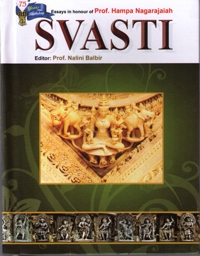20
Some Observations on Buddhist and Jaina Ethics
The points of similarity between the Buddhistic and the Jaina views of life are so glaringly evident that one is likely to miss the distinction between the two which is perhaps equally important, if not more, to understand them in their proper perspective. The attitude of Lord Buddha for the Jaina sādhus is refected in the Upālisutta, where he asks Upāli, a convert from Jainism to show the same respect for Jaina sādhus as before conversion. Lord Buddha himself, is said to have once led a life in which he remained naked, took his food in the cavity of his hand and plucked out his hair with his hands.[1 ] Obviously, this resembles the Jaina mode of living of a monk. In fact, Devasena, a Jaina author, has said in his book Darśanasāra that Lord Buddha was once a disciple of Jaina monk, Pihitasarva.
In any case, what brought Jainism and Buddhism together was not only the similarity between the two but also their common attitude towards Brahmanism. They differed from the orthodox Vedic religion inasmuch as they divorced spiritualism from a social philosophy, with which the former has intermingled it. This central difference led to many other differences. The enthusiasm of the Jainas and the Buddhists for spiritual emancipation of the individual made them indifferent to the secular problems of society. They rejected the life of worldly activity in favour of a life of peaceful contemplation, stressed on asceticism and held the overall supremacy of a monk over a householder.[2] Being indifferent to social problems, they remained indifferent to the caste system as a social institution and opposed it as a ban on entering the spiritual life. In the Aśokāvadāna, it is said that the caste is to be taken into consideration in the context of marriage and not in the context of spiritualism.
āvāhakāle ’tha vivāhakāle jāteḥ parīkṣā na tu dharmakāle/
dharmakriyāyāṃ hi guṇā nimittā guṇāś ca jātiṃ na vicārayanti//Somadeva has summarised the whole position by saying that those general customs of the society which are not contrary to the spiritual code of morality should be followed by the Jainas:
sarva eva hi Jainānāṃ pramāṇaṃ laukiko vidhiḥ |
yatra samyaktvahānir na yatra na vratadūṣaṇam || [3]It was on this basis that violence in the sacrifices was condemned.[4] It would be interesting to note that the Jainas today perform sacrifices on special occasions like that of installation of the image. Even the authority of the Vedas was challenged by both of them because they teach violence.[5]
This emphasis on individualism led to the emphasis on the dignity of an individual. An individual need not bow before any God, who, in fact, does not exist at all. The gods, however, even though existing, bow before the power of a spiritual personality.[6] We need not seek any help from outside. “Thou art thy own friend and you yourself make an effort,” said Lord Mahāvīra.[7] “Lead a life, being a lamp to yourselves”, said Lord Buddha.[8] We are the architects of our fate, no supra-human power interferes. It is through intense human exertion that one has to seek emancipation from the sufferings and miseries of life. It is this belief in the efficacy of human exertion, from which, both the Jainas and the Buddhists derive their common name, śramaṇa, which comes from the root śram-, to exert.
Lord Buddha gave the central theme of his ethics in the first sermon at Sarnath, in which he dwelt upon the untold miseries and sufferings of the world. He declared: “Birth is misery; old age, decay, sickness, death, sorrow, grief, woe, lamentation and despair are miseries, not to get what one desires is also misery.”[9] The Uttarādhayayana speaks in rather a poetic tone. “All singing is but prattle, all dancing is but mocking, all ornaments are but a burden, all pleasures produce but pain.” In fact the pressure of the problem of misery was already felt acutely in the Upaniṣads. In the Chāndogyopaniṣad, Nārada is said to have approached Sanatkumāra with the request, “O Lord; I am in grief; lead me to the shore that lies beyond grief.”
This attitude gave an ascetic tinge to Śramaṇism as well as to post-Buddhist Brahmanism. Here Buddha took care to ask his followers to avoid extremes and follow the middle path, which balances self-indulgence, and self-mortification. There are indications that Buddha was criticised for allowing many enjoyments, which the public opinion at that time did not consider proper for monks.[10] The ancient commentators explain that the Sūtrakr̥tāṅga also criticises the Buddhist mode of life as being too comfortable.[11] The Jainas, however, distinguish themselves in the severest austerities. In the beginning of his career Lord Buddha also performed such austerities; but gave them up later on realising that they were not useful for enlightenment. Even then, some of his followers continued to practise such austerities under the name of dhūtāṅgas.[12] In fact, we find traces of distinction between those Bhikkhus who were hermits and loved solitary lives in the woods and those who moved about in bands, frequenting rest houses.[13] This distinction, later on, led to the schism in the form of Hinayāna, which laid more emphasis on the love of solitude, and Mahāyāna which laid more emphasis on the universal compassion towards the suffering creatures.
In the history of Jainism, however, the penance has held throughout an essential position in the scheme of ethics. The Uttarādhyayana says: “As a large tank, when its supply of water has been stopped gradually, dries up by the consumption of water and by evaporation, so the Karman of a monk, which he has acquired in crores of births, is annihilated by austerities.”[14]
Non-violence is the most important characteristic of asceticism. If suffering is an evil, it is also an evil to inflict suffering on others. So far, both the traditions of Śramaṇism agree. But keeping with the general trend, the Jainas went to the extreme in this case also. Buddha allowed pure meat which is not seen, nor heard, nor supposed to be prepared,[15] even though Devadatta, who was an advocate of dhūtāṅgas requested him to restrict admission to his order only to vegetarians. Though a controversy whether Mahāvīra allowed meat or not is carried on by some scholars like Paṇḍita Sukhalāla Samghavi, yet by and large the creed of non-violence in Jainism seems to be irreconcilable with flesh eating.[16]
But this seems to be rather a minor difference because Lord Buddha also prohibited moving about of the monks[17] in the rainy season and cutting of even trees and grass[18] out of regard for life, which shows that he was no less particular about non-violence. We should avoid inflicting of misery on others but are we under any obligation to alleviate the miseries of others also? Sāntideva says that the world is just like a body, the constituents of which are like its limbs and the happiness of the one part belongs to the whole:
hastādibhedena bahuprakāraḥ kāyo yathaikaḥ paripālanīyaḥ
tathā jagadbhinnam abhinnaduḥkhasukhātmakaṃ sarvam idaṃ tathaiva
(Bodhicaryāvatāra 8.91)Of what use is the dry liberation, which dwindles into insignificance before the oceans of the ecstacies of the creatures being freed?
mucyamāneṣu sattveṣu ye te prāmodyasāgarāḥ |
tair eva nanu paryāptaṃ mokṣenārasikena kim || (8.108)Obviously this trend became more prominent in the Mahāyāna school. The Bodhisattva’s only wish is to do good to others.[19] The Jainas however, emphasized more the negative precepts of non-injury. On a minute observation, they realised that the idea of helping the helpless is neither compatible with the high standards of detachment and asceticism nor with the concept of absolute non-violence itself. Any worldly help to a man would imply attachment on the side of one who gives it and the propagation of mundane activities on the side of one who receives it.[20] It seems somewhat strange why the Buddhists should not have criticized the Jainas for holding such a restricted and negative view of non-violence and why the Jainas should have spared the Buddhists for allowing flesh eating, even though holding themselves to be the votaries of non-violence.
The Jaina view of non-violence led to an idea of supra-moral plan of ethics. The moral plan of life, which is vyavahāra dharma, admits of a distinction between the good and the bad. But this is not the ultimate aim of ethics. The niścaya dharma consists of transcending the duality of good and bad. The good and the bad, says Kundakundācārya, are both like the shackles of gold and iron respectively, and as such, both of them bind us to the physical world.[21] No doubt that the intermediate path of morality is to be preferred to the path of immoral practices, because as Pūjyapāda says, is it not better to wait in the cool shade rather than in the hot sun?[22]
Lord Buddha must have also thought only śīla or conduct is insufficient as he has recommended samādhi also. In Buddhism also, all acts, whether good or bad are considered impure from the point of view of meditation.[23] Buddhism, however, could never have gone to the extreme of considering even the virtuous activities as a hindrance to liberation. The Jainas argued that the virtuous action leads to wealth, wealth to pride, pride to infatuation and infatuation to sin and, therefore, let there be no actions for us.[24] It is to be noted that this condemnation of virtue is connected with the condemnation of vice. The Jainas have included the vow of non-possession in their moral vows, which the Buddhists have not, even though they also prescribed a very limited number of possessions for a monk - three robes, a girdle, an alms-bowl, razor, a needle and a water strainer.
In Buddhism, the concept of supra-moral plan of life seems to have degenerated in the form of Tantric Buddhism. It is true that ‘we do not always understand the symbolical language in which they were writers’[25] yet any doctrine which says that nirvāṇa can be found in the blissful embrace of a young girl,[26] there can be no liberation without a female partner[27] and lust is crushed by lust[28] is bound to be abused by the common man. Thus the abstract idea of nirvāṇa was replaced by the idea of mahāsukha[29] which led to a code of morality which is sometimes diametrically opposed to what Lord Buddha himself taught.
We find a period of moral decadence in the history of Jaina ethics also. In the commentary on Niśītha (the name, meaning ‘night’ symbolically indicates its secret nature), we find some striking examples of moral degeneration. A monk, for example, is allowed to use ‘oil of swan’ as a medicine, which is prepared by the cruel method of piercing the body of the swan, filling its body with medicines and then boiling it on oil.[30] A monk is declared as pure even after he has killed lions to safeguard the saṃgha in a forest.[31] A monk is asked by the ācārya to kill the Brāhmaṇas by magic, because the king compelled the Jaina monks to touch the feet of those Brāhmaṇas.[32] We have, on the other hand, the attitude of equanimity of Pārśva to Dharaṇendra and Kamaṭha when the former tried to save him from the latter who tried to kill him. In the Br̥hatkalpabhāṣya, we also find that a senior monk tells lie to a junior monk about the water, which though impure, is declared by him to be pure, because he wants to take it.[33]
But the distinction between the attitude of the Jainas and the Buddhists should not be overlooked. The Jainas allowed these practices only as an allowance for human weakness but did not consider them as helpful for liberation whereas the later Buddhists recommended such practices on the ground of the theory that lust is crushed by lust and considered them to be a means to liberation.
Another point to be noted is the attitude of the Jainas towards the relation of the metaphysics and ethics. Buddha kept silence over so many metaphysical problems, which have a close bearing on ethics. The nature of ātman and nirvāṇa are the two main problems of this type. Such metaphysical queries are rejected by Lord Buddha as they do not promote the moral well-being of the aspirant. A wounded man should not waste his time and energy in making worthless enquiries about the caste and family etc., of the man who wounded him and about the shape etc., of the arrow.[34] The question about the nature of the liberated soul is a wilderness, a desert, a puppet show and it does not encourage distaste for the world, absence of passion, distance for the world, absence of passion, cessation of evil, knowledge, perfect enlightenment or nirvāṇa.[35] When Lord Buddha was compelled to explain his silence over the question whether ātman existed or not, he replied that he wanted neither to side with those who held ātman to be eternal (śāśvatavāda) nor with those who believed in nihilism (ucchedavāda).[36] Similarly, though nirvāṇa is mostly described in negative terms,[37] yet it is described sometimes as a state of happiness also.[38]
Jainism adopted the attitude of non-absolutism in such matters by which the apparent contradiction of statements would be logically explained. In fact, Samantabhadra’s criticism of the doctrine holding the world and the self as absolutely transitory is based on ethical grounds. He says that all moral distinction between the antithesis of bondage and liberation, puṇya and pāpa, heaven and hell, pleasure and pain will be blurred if we were not to accept that things are partly temporary and partly permanent.[39] This silence of Lord Buddha led to a greater schism in Buddhism, whereas a definiteness of the Jaina attitude did not allow an evolution of the metaphysical ideas to any appreciable degree. It is important to note that Aśoka, who showed great interest in the propagation of Buddhist ethics, did not speak of nirvāṇa at all, though lie refers to the other world.
In any case, it is the unanimity on the ethical implications of the doctrine of Karman which binds all the three great Aryan religions of India viz., Brahmanism, Jainism and Buddhism, in a common link. If it is true that as you sow so shall you reap, the reverse of it is equally true. It was on account of this similarity that older Brahmanism showed a great receptivity to the new religion of the Jainas and the Buddhists. A life of introversion and contemplation becomes as important for Hinduism as it was for Śramanism. In the Yogavāsiṣṭha, Rāma says, “I am not Rāma, my mind is not attached to anything. I want to remain self-absorbed and calm as Jina”:
nāham rāmo na me vāñchā vibhave na ca me manaḥ/
śānta āsitum icchāmi svātmanīva jino yathā//Thus the birth of Jainism and Buddhism led to a synthetic culture.
The basic difference, however, as already indicated, between Brahmanism and Jainism is that the latter divorced spiritualism from social philosophy. As regards the Jainas and the Buddhists, the former represent the extremists whereas the latter were moderate in ethical principles.
In this discussion, it would not be out of place to mention a strange phenomena. All the Tīrthaṅkaras, who preached non-violence, came from the Kṣatriya class, who were warriors. But today, their followers come only from the business community, who are not only peace-loving but also of compromising nature.
The utility of the theory of passions, which the ascetic religions teach, will have also to be reconsidered in the light of modern psychology which teaches their sublimation rather than their suppression. Similarly, when science and socialism are engaged in making the whole of the society rich and prosperous, the glorification of self-mortification and poverty in the form of non-possessiveness will have also to be reinterpreted. It seems that Buddhist ethics may prove to be more helpful than Jaina ethics in this effort. But non-absolutism may suit more for modern times when we like to be rational and not dogmatic in our thinking.
 Prof. Dr. D.N. Bhargava
Prof. Dr. D.N. Bhargava

